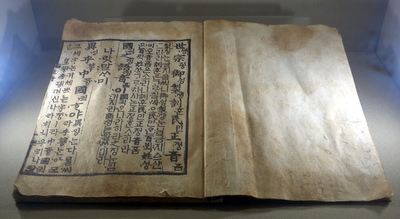Difference between revisions of "Hangul"
From SamuraiWiki
Jump to navigationJump to search (Created page with "*''Korean'': 韓㐎・한글 ''(Hangul)'' ''Hangul'' is the chief writing system employed in Korea. Devised by King Sejong in the 15th century, it uses consonant and vowe...") |
|||
| Line 1: | Line 1: | ||
| + | [[File:Hunminjeongeum.jpg|right|thumb|400px|A copy of ''[[Hunminjeongeum]]'' on display at the King Sejong Story museum in Seoul]] | ||
*''Korean'': 韓㐎・한글 ''(Hangul)'' | *''Korean'': 韓㐎・한글 ''(Hangul)'' | ||
Revision as of 08:50, 26 July 2017

A copy of Hunminjeongeum on display at the King Sejong Story museum in Seoul
- Korean: 韓㐎・한글 (Hangul)
Hangul is the chief writing system employed in Korea. Devised by King Sejong in the 15th century, it uses consonant and vowel elements which combine to form syllabic characters. Traditionally used alongside Chinese characters (K: hanja), in recent times Korea has largely turned to using hangul almost exclusively.
Hangul is said to have been introduced in 1443, but Hunminjeongeum, a book organized by King Sejong which formally describes and explains the writing system, was published three years later. Meanwhile, in 1445, Sejong released an epic entitled "Songs of Flying Dragons" (K: Yongbi Eocheonga), which describes the founding of the Joseon Dynasty in five books (ten volumes, 125 chapters), in both hangul and hanja.
References
- Gallery labels, The Story of King Sejong museum exhibit, Seoul.